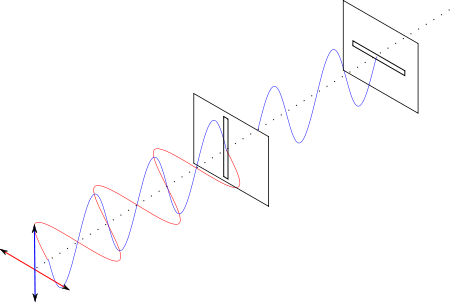
The plane of polarisation is:
(This question has multiple answers)
A) The plane in which vibrations of electric vectors takes place.
B) A plane perpendicular to the plane in which the vibrations of the electric vector takes place.
C) Perpendicular to the plane of vibration
D) Horizontal plane
Answer
574.8k+ views
Hint: The polarisation principle arises when we want to enter only the electromagnetic - waves of our wish. The polarisation means allowing light rays based on its geometric orientation. There are two orientations called horizontal and vertical. The process of polarization is done by polarisers. And the plane of polarisation is the direction of light rays the polariser allows or the direction of polarization.
Complete step by step answer:
(i) The plane of polarisation is the direction of polarisation.
(ii) The plane of vibration is the plane in which the vibration of the electric vector takes place.
(iii) Hence we can that the plane of vibration is perpendicular to the plane of polarisation.
Hence the correct options among the given options are B and C.
Additional information:

(i) The term polarisation means allowing the electromagnetic waves of a particular orientation to either be horizontal or vertical.
(ii) The plane which allows the electromagnetic waves is called a polariser. And the plane perpendicular to the polarizer is called an analyzer.
(iii) The plane of polarisation is the direction of propagation of the polarized light. And it is perpendicular to the plane of vibration.
(iv) This phenomenon was first identified by Malus in 1908. And he provided a law called “Malus law" He states that When light is polarised by the polariser, its irradiance,
$I = {I_0}{\cos ^2}\theta $,
Where ${I_0}$ is the intensity of the light and
$\theta $ is the angle between the light’s orientation before polarisation and the axis of the polariser.
(v) Polarisation is a principle that is applied in photography to avoid the unwanted light, in the Liquid Crystal Display, in radio transmission, etc.
Note:
The plane of polarization is the direction of the propagation of the polarised light. And the plane of polarization is perpendicular to the plane in which the electric field vectors vibrate. Hence the direction of the polarised light is perpendicular to the un-polarised light. The polarisation is done by the polariser. Polarisation is the basic principle used in screens like LCD’s etc.
Complete step by step answer:
(i) The plane of polarisation is the direction of polarisation.
(ii) The plane of vibration is the plane in which the vibration of the electric vector takes place.
(iii) Hence we can that the plane of vibration is perpendicular to the plane of polarisation.
Hence the correct options among the given options are B and C.
Additional information:

(i) The term polarisation means allowing the electromagnetic waves of a particular orientation to either be horizontal or vertical.
(ii) The plane which allows the electromagnetic waves is called a polariser. And the plane perpendicular to the polarizer is called an analyzer.
(iii) The plane of polarisation is the direction of propagation of the polarized light. And it is perpendicular to the plane of vibration.
(iv) This phenomenon was first identified by Malus in 1908. And he provided a law called “Malus law" He states that When light is polarised by the polariser, its irradiance,
$I = {I_0}{\cos ^2}\theta $,
Where ${I_0}$ is the intensity of the light and
$\theta $ is the angle between the light’s orientation before polarisation and the axis of the polariser.
(v) Polarisation is a principle that is applied in photography to avoid the unwanted light, in the Liquid Crystal Display, in radio transmission, etc.
Note:
The plane of polarization is the direction of the propagation of the polarised light. And the plane of polarization is perpendicular to the plane in which the electric field vectors vibrate. Hence the direction of the polarised light is perpendicular to the un-polarised light. The polarisation is done by the polariser. Polarisation is the basic principle used in screens like LCD’s etc.
Recently Updated Pages
A man running at a speed 5 ms is viewed in the side class 12 physics CBSE

The number of solutions in x in 02pi for which sqrt class 12 maths CBSE

State and explain Hardy Weinbergs Principle class 12 biology CBSE

Write any two methods of preparation of phenol Give class 12 chemistry CBSE

Which of the following statements is wrong a Amnion class 12 biology CBSE

Differentiate between action potential and resting class 12 biology CBSE

Trending doubts
What are the major means of transport Explain each class 12 social science CBSE

Which are the Top 10 Largest Countries of the World?

Draw a labelled sketch of the human eye class 12 physics CBSE

Explain sex determination in humans with line diag class 12 biology CBSE

Explain sex determination in humans with the help of class 12 biology CBSE

Differentiate between homogeneous and heterogeneous class 12 chemistry CBSE




